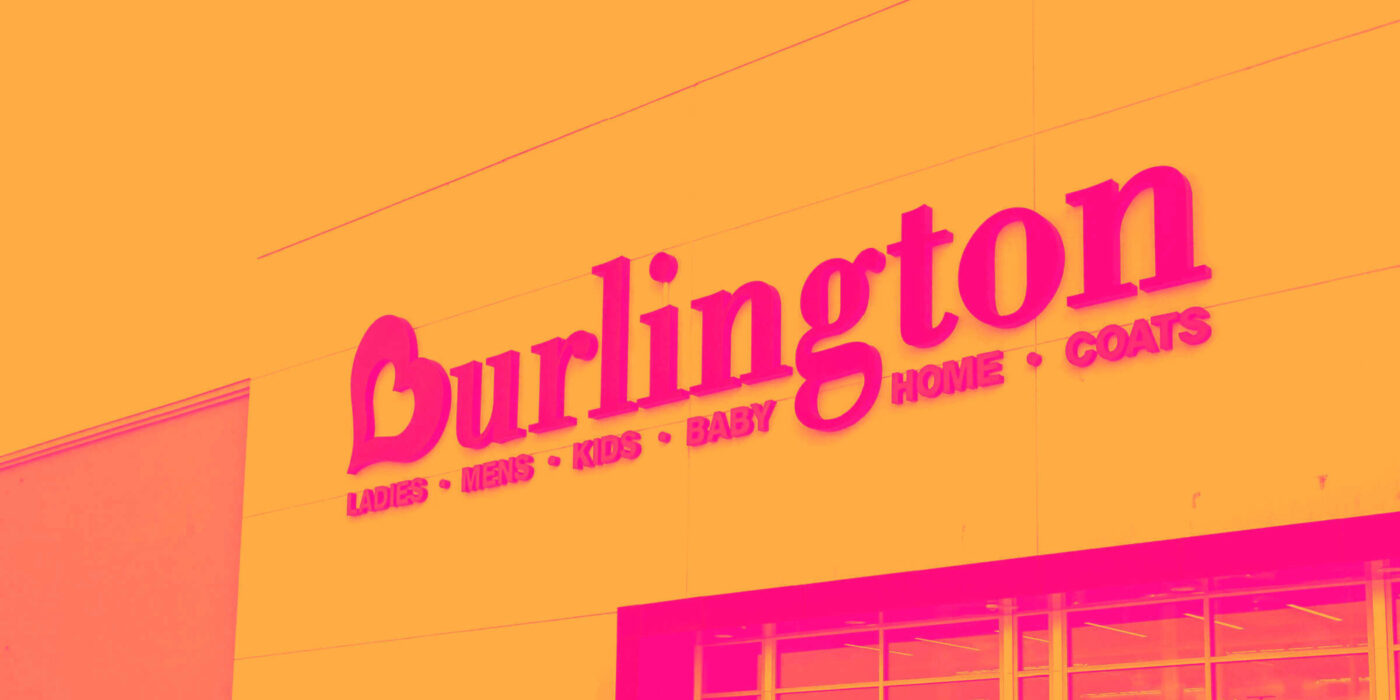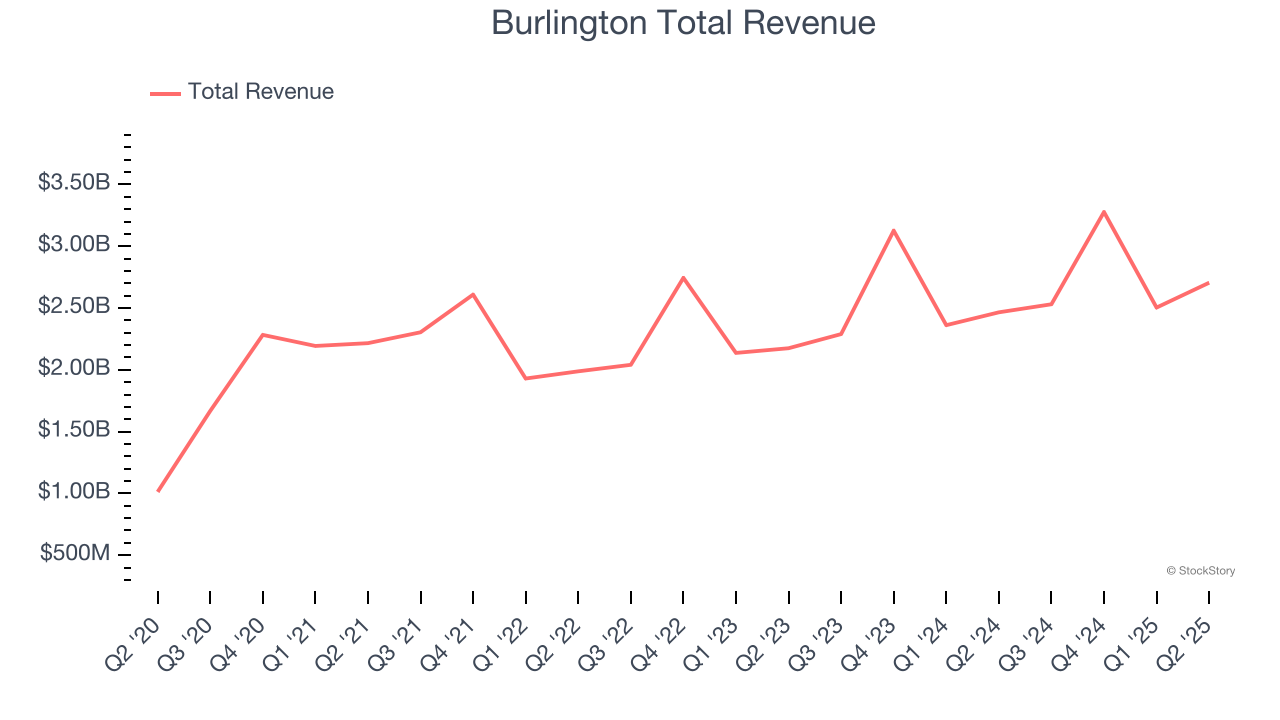
Let’s dig into the relative performance of Burlington (NYSE:BURL) and its peers as we unravel the now-completed Q2 discount retailer earnings season.
Discount retailers understand that many shoppers love a good deal, and they focus on providing excellent value to shoppers by selling general merchandise at major discounts. They can do this because of unique purchasing, procurement, and pricing strategies that involve scouring the market for trendy goods or buying excess inventory from manufacturers and other retailers. They then turn around and sell these snacks, paper towels, toys, clothes, and myriad other products at highly enticing prices. Despite the unique draw and lure of discounts, these discount retailers must also contend with the secular headwinds of online shopping and challenged retail foot traffic in places like suburban strip malls.
The 5 discount retailer stocks we track reported a strong Q2. As a group, revenues beat analysts’ consensus estimates by 2% while next quarter’s revenue guidance was 1.8% below.
In light of this news, share prices of the companies have held steady. On average, they are relatively unchanged since the latest earnings results.
Burlington (NYSE:BURL)
Founded in 1972 as a discount coat and outerwear retailer, Burlington Stores (NYSE:BURL) is now an off-price retailer that has broadened into general apparel, footwear, and home goods.
Burlington reported revenues of $2.71 billion, up 9.7% year on year. This print exceeded analysts’ expectations by 2.5%. Overall, it was a strong quarter for the company with an impressive beat of analysts’ EBITDA estimates and a beat of analysts’ EPS estimates.
Michael O’Sullivan, CEO, stated, “We are pleased with our exceptional performance in the second quarter. Comparable store sales increased 5%, which was on top of 5% comparable store sales growth in the second quarter of last year. We also saw very strong margin and earnings performance. Adjusted EBIT Margin increased 120 basis points, while Adjusted EPS grew 39% versus the second quarter of last year. This was a high-quality earnings beat driven by ahead of plan sales, higher merchandise margin, lower freight expense and leverage on SG&A expenses.”

The market was likely pricing in the results, and the stock is flat since reporting. It currently trades at $281.55.
Is now the time to buy Burlington? Access our full analysis of the earnings results here, it’s free.
Best Q2: Five Below (NASDAQ:FIVE)
Often facilitating a treasure hunt shopping experience, Five Below (NASDAQ:FIVE) is an American discount retailer that sells a variety of products from mobile phone cases to candy to sports equipment for largely $5 or less.
Five Below reported revenues of $1.03 billion, up 23.7% year on year, outperforming analysts’ expectations by 3.5%. The business had an exceptional quarter with EPS guidance for next quarter exceeding analysts’ expectations and a solid beat of analysts’ EBITDA estimates.

Five Below delivered the biggest analyst estimates beat and fastest revenue growth among its peers. However, the results were likely priced into the stock as it’s traded sideways since reporting. Shares currently sit at $143.25.
Is now the time to buy Five Below? Access our full analysis of the earnings results here, it’s free.
Slowest Q2: TJX (NYSE:TJX)
Initially based on a strategy of buying excess inventory from manufacturers or other retailers, TJX (NYSE:TJX) is an off-price retailer that sells brand-name apparel and other goods at prices much lower than department stores.
TJX reported revenues of $14.4 billion, up 6.9% year on year, exceeding analysts’ expectations by 1.7%. It was a satisfactory quarter as it also posted an impressive beat of analysts’ EBITDA estimates but EPS guidance for next quarter missing analysts’ expectations.
Interestingly, the stock is up 3.7% since the results and currently trades at $139.57.
Read our full analysis of TJX’s results here.
Ross Stores (NASDAQ:ROST)
Selling excess inventory or overstocked items from other retailers, Ross Stores (NASDAQ:ROST) is an off-price concept that sells apparel and other goods at prices much lower than department stores.
Ross Stores reported revenues of $5.53 billion, up 4.6% year on year. This result was in line with analysts’ expectations. Taking a step back, it was a satisfactory quarter as it also recorded EPS guidance for next quarter exceeding analysts’ expectations but a slight miss of analysts’ EBITDA estimates.
Ross Stores had the weakest performance against analyst estimates and slowest revenue growth among its peers. The stock is up 2% since reporting and currently trades at $148.60.
Read our full, actionable report on Ross Stores here, it’s free.
Ollie's (NASDAQ:OLLI)
Often located in suburban or semi-rural shopping centers, Ollie’s Bargain Outlet (NASDAQ:OLLI) is a discount retailer that acquires excess inventory then sells at meaningful discounts.
Ollie's reported revenues of $679.6 million, up 17.5% year on year. This number surpassed analysts’ expectations by 2.7%. It was a very strong quarter as it also put up a solid beat of analysts’ EBITDA estimates and an impressive beat of analysts’ gross margin estimates.
Ollie's achieved the highest full-year guidance raise among its peers. The stock is down 2.4% since reporting and currently trades at $127.50.
Read our full, actionable report on Ollie's here, it’s free.
Market Update
As a result of the Fed’s rate hikes in 2022 and 2023, inflation has come down from frothy levels post-pandemic. The general rise in the price of goods and services is trending towards the Fed’s 2% goal as of late, which is good news. The higher rates that fought inflation also didn't slow economic activity enough to catalyze a recession. So far, soft landing. This, combined with recent rate cuts (half a percent in September 2024 and a quarter percent in November 2024) have led to strong stock market performance in 2024. The icing on the cake for 2024 returns was Donald Trump’s victory in the U.S. Presidential Election in early November, sending major indices to all-time highs in the week following the election. Still, debates around the health of the economy and the impact of potential tariffs and corporate tax cuts remain, leaving much uncertainty around 2025.
Want to invest in winners with rock-solid fundamentals? Check out our Top 5 Quality Compounder Stocks and add them to your watchlist. These companies are poised for growth regardless of the political or macroeconomic climate.
StockStory is growing and hiring equity analyst and marketing roles. Are you a 0 to 1 builder passionate about the markets and AI? See the open roles here.
